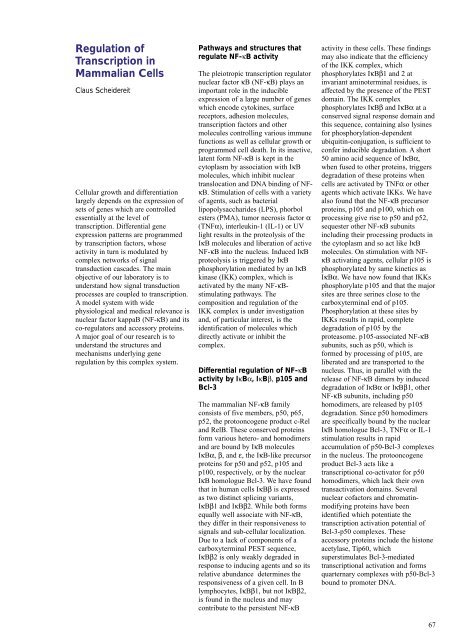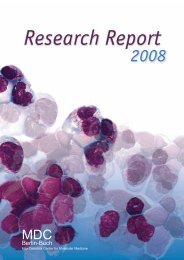Create successful ePaper yourself
Turn your PDF publications into a flip-book with our unique Google optimized e-Paper software.
Regulation of<br />
Transcription in<br />
Mammalian Cells<br />
Claus Scheidereit<br />
Cellular growth and differentiation<br />
largely depends on the expression of<br />
sets of genes which are controlled<br />
essentially at the level of<br />
transcription. Differential gene<br />
expression patterns are programmed<br />
by transcription factors, whose<br />
activity in turn is modulated by<br />
complex networks of signal<br />
transduction cascades. The main<br />
objective of our laboratory is to<br />
understand how signal transduction<br />
processes are coupled to transcription.<br />
A model system with wide<br />
physiological and medical relevance is<br />
nuclear factor kappaB (NF-κB) and its<br />
co-regulators and accessory proteins.<br />
A major goal of our research is to<br />
understand the structures and<br />
mechanisms underlying gene<br />
regulation by this complex system.<br />
Pathways and structures that<br />
regulate NF-κB activity<br />
The pleiotropic transcription regulator<br />
nuclear factor κB (NF-κB) plays an<br />
important role in the inducible<br />
expression of a large number of genes<br />
which encode cytokines, surface<br />
receptors, adhesion molecules,<br />
transcription factors and other<br />
molecules controlling various immune<br />
functions as well as cellular growth or<br />
programmed cell death. In its inactive,<br />
latent form NF-κB is kept in the<br />
cytoplasm by association with IκB<br />
molecules, which inhibit nuclear<br />
translocation and DNA binding of NFκB.<br />
Stimulation of cells with a variety<br />
of agents, such as bacterial<br />
lipopolysaccharides (LPS), phorbol<br />
esters (PMA), tumor necrosis factor α<br />
(TNFα), interleukin-1 (IL-1) or UV<br />
light results in the proteolysis of the<br />
IκB molecules and liberation of active<br />
NF-κB into the nucleus. Induced IκB<br />
proteolysis is triggered by IκB<br />
phosphorylation mediated by an IκB<br />
kinase (IKK) complex, which is<br />
activated by the many NF-κBstimulating<br />
pathways. The<br />
composition and regulation of the<br />
IKK complex is under investigation<br />
and, of particular interest, is the<br />
identification of molecules which<br />
directly activate or inhibit the<br />
complex.<br />
Differential regulation of NF-κB<br />
activity by IκBα, IκBβ, p105 and<br />
Bcl-3<br />
The mammalian NF-κB family<br />
consists of five members, p50, p65,<br />
p52, the protooncogene product c-Rel<br />
and RelB. These conserved proteins<br />
form various hetero- and homodimers<br />
and are bound by IκB molecules<br />
IκBα, β, and ε, the IκB-like precursor<br />
proteins for p50 and p52, p105 and<br />
p100, respectively, or by the nuclear<br />
IκB homologue Bcl-3. We have found<br />
that in human cells IκBβ is expressed<br />
as two distinct splicing variants,<br />
IκBβ1 and IκBβ2. While both forms<br />
equally well associate with NF-κB,<br />
they differ in their responsiveness to<br />
signals and sub-cellular localization.<br />
Due to a lack of components of a<br />
carboxyterminal PEST sequence,<br />
IκBβ2 is only weakly degraded in<br />
response to inducing agents and so its<br />
relative abundance determines the<br />
responsiveness of a given cell. In B<br />
lymphocytes, IκBβ1, but not IκBβ2,<br />
is found in the nucleus and may<br />
contribute to the persistent NF-κB<br />
activity in these cells. These findings<br />
may also indicate that the efficiency<br />
of the IKK complex, which<br />
phosphorylates IκBβ1 and 2 at<br />
invariant aminoterminal residues, is<br />
affected by the presence of the PEST<br />
domain. The IKK complex<br />
phosphorylates IκBβ and IκBα at a<br />
conserved signal response domain and<br />
this sequence, containing also lysines<br />
for phosphorylation-dependent<br />
ubiquitin-conjugation, is sufficient to<br />
confer inducible degradation. A short<br />
50 amino acid sequence of IκBα,<br />
when fused to other proteins, triggers<br />
degradation of these proteins when<br />
cells are activated by TNFα or other<br />
agents which activate IKKs. We have<br />
also found that the NF-κB precursor<br />
proteins, p105 and p100, which on<br />
processing give rise to p50 and p52,<br />
sequester other NF-κB subunits<br />
including their processing products in<br />
the cytoplasm and so act like IκB<br />
molecules. On stimulation with NFκB<br />
activating agents, cellular p105 is<br />
phosphorylated by same kinetics as<br />
IκBα. We have now found that IKKs<br />
phosphorylate p105 and that the major<br />
sites are three serines close to the<br />
carboxyterminal end of p105.<br />
Phosphorylation at these sites by<br />
IKKs results in rapid, complete<br />
degradation of p105 by the<br />
proteasome. p105-associated NF-κB<br />
subunits, such as p50, which is<br />
formed by processing of p105, are<br />
liberated and are transported to the<br />
nucleus. Thus, in parallel with the<br />
release of NF-κB dimers by induced<br />
degradation of IκBα or IκBβ1, other<br />
NF-κB subunits, including p50<br />
homodimers, are released by p105<br />
degradation. Since p50 homodimers<br />
are specifically bound by the nuclear<br />
IκB homologue Bcl-3, TNFα or IL-1<br />
stimulation results in rapid<br />
accumulation of p50-Bcl-3 complexes<br />
in the nucleus. The protooncogene<br />
product Bcl-3 acts like a<br />
transcriptional co-activator for p50<br />
homodimers, which lack their own<br />
transactivation domains. Several<br />
nuclear cofactors and chromatinmodifying<br />
proteins have been<br />
identified which potentiate the<br />
transcription activation potential of<br />
Bcl-3-p50 complexes. These<br />
accessory proteins include the histone<br />
acetylase, Tip60, which<br />
superstimulates Bcl-3-mediated<br />
transcriptional activation and forms<br />
quarternary complexes with p50-Bcl-3<br />
bound to promoter DNA.<br />
67

















